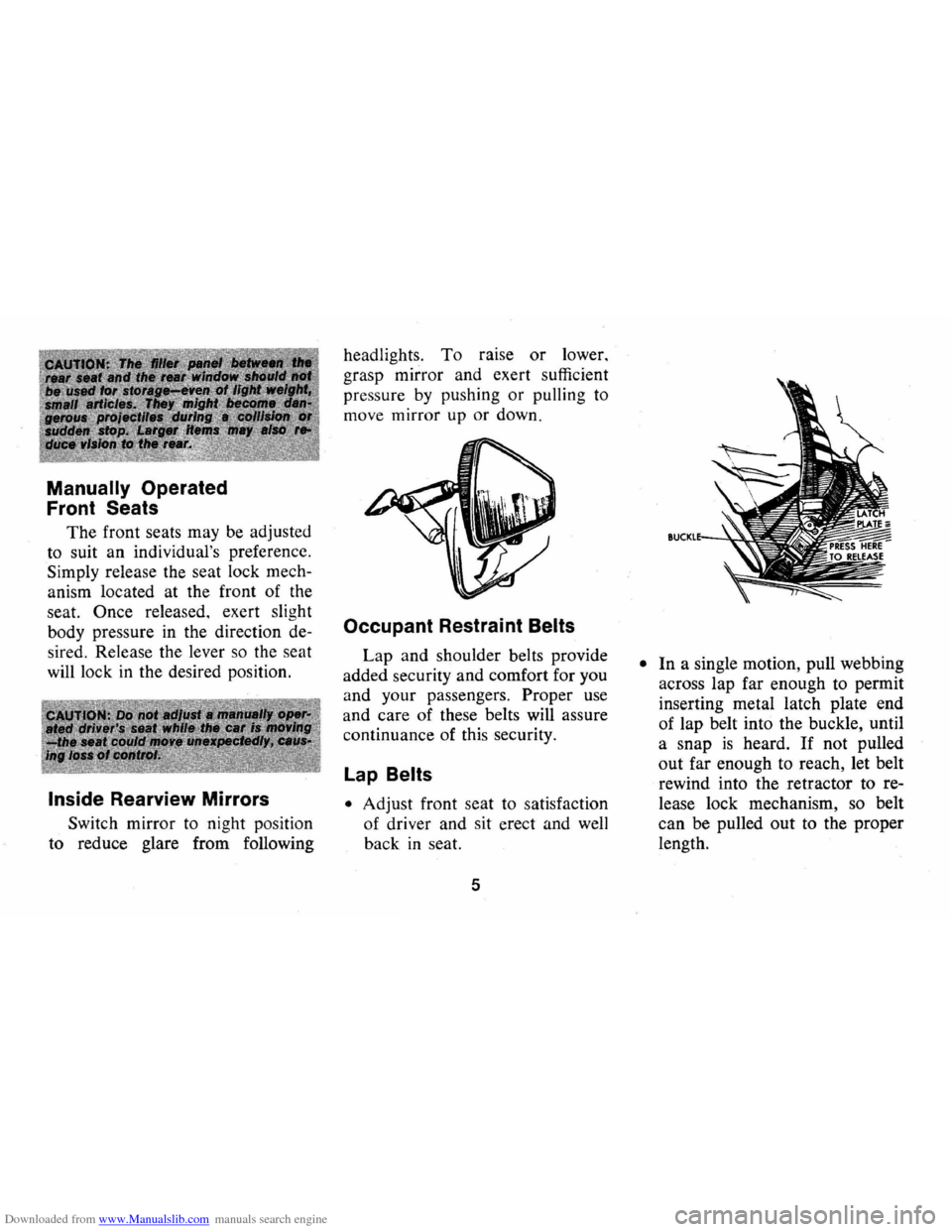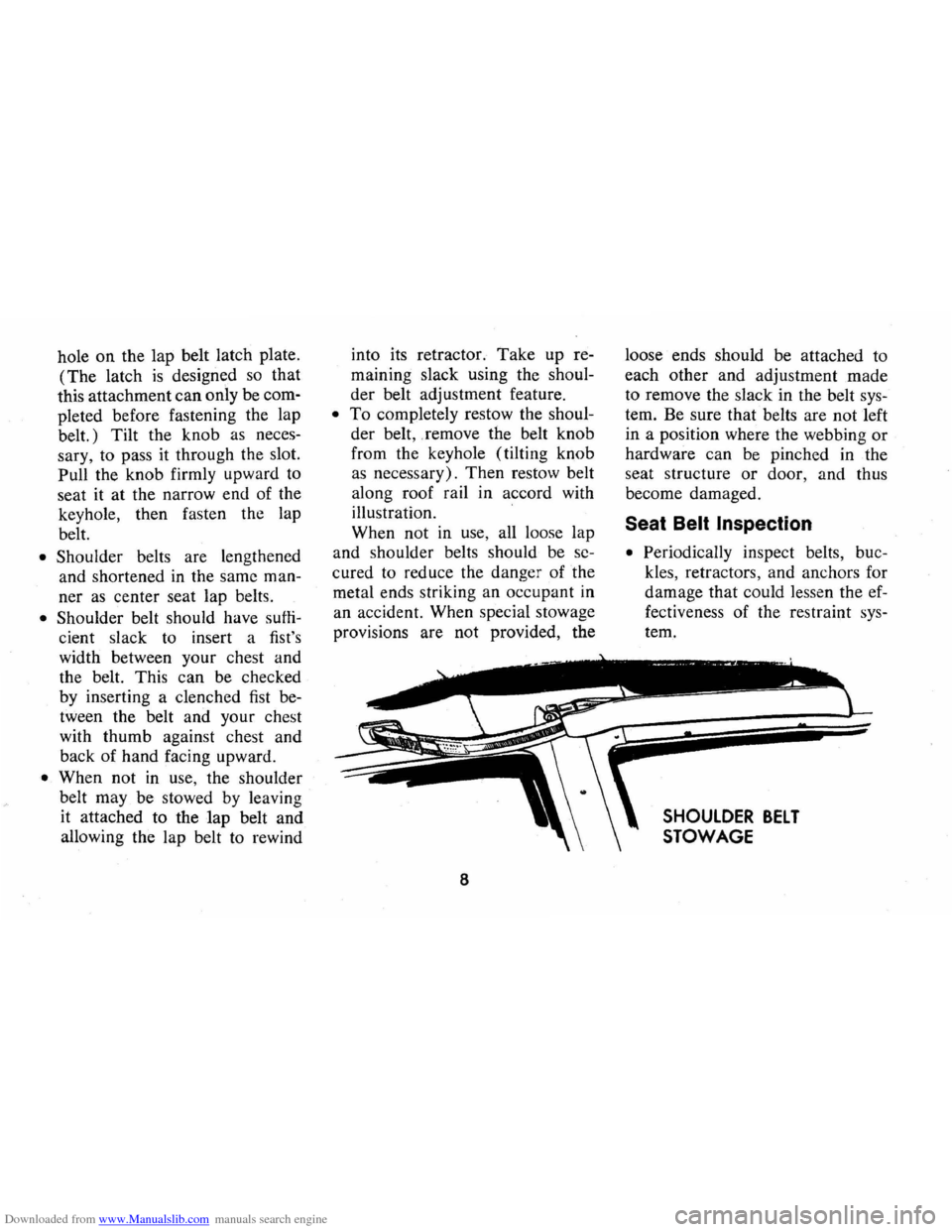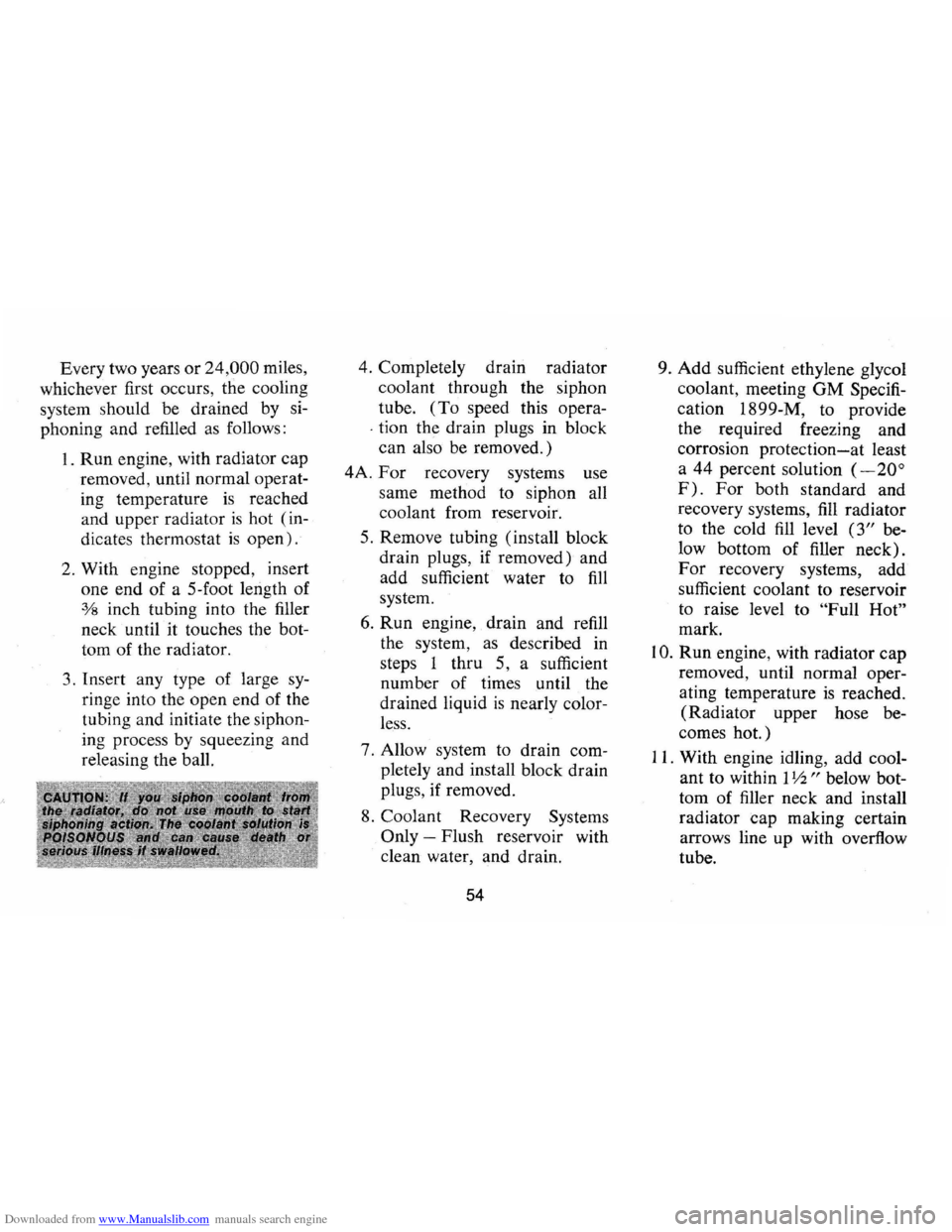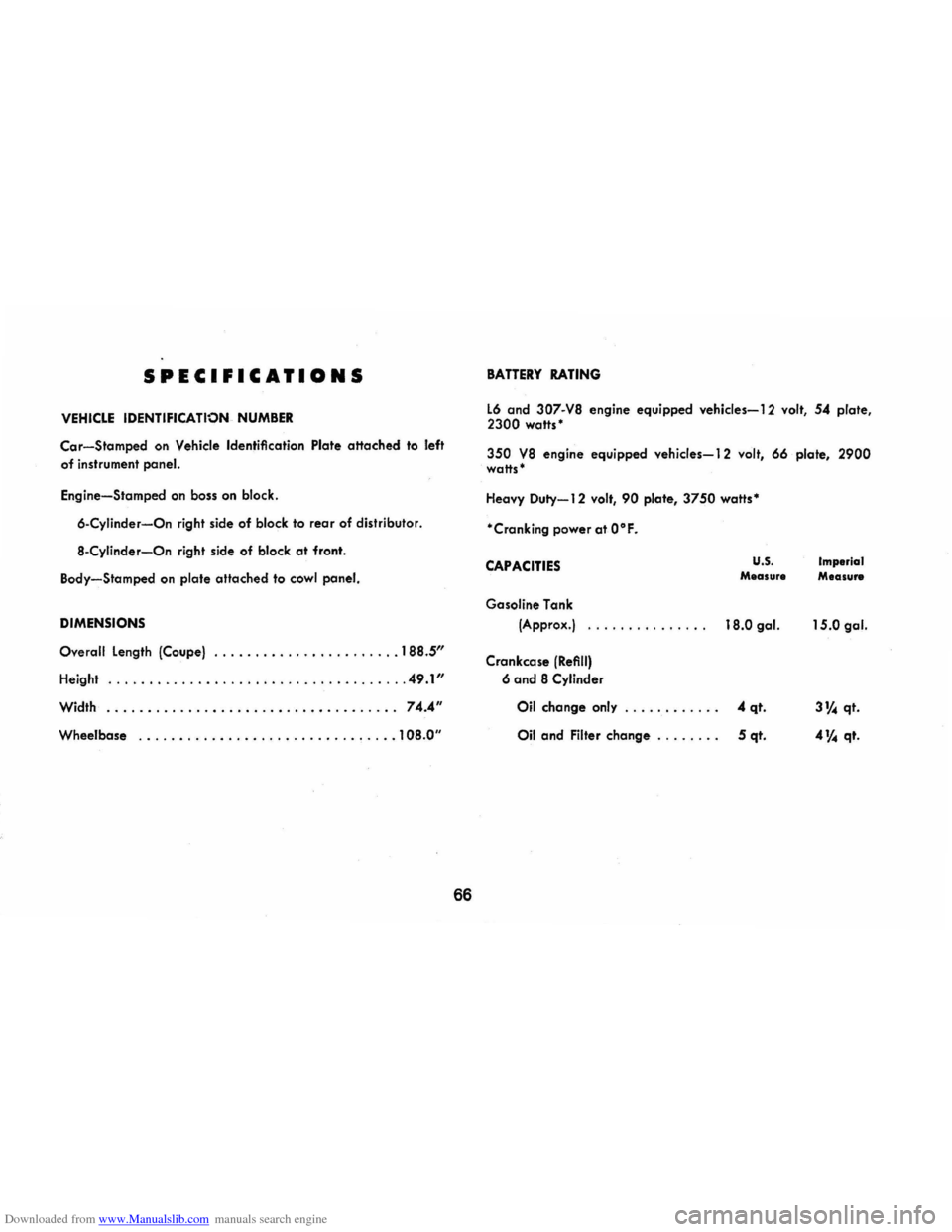1973 CHEVROLET CAMARO length
[x] Cancel search: lengthPage 8 of 84

Downloaded from www.Manualslib.com manuals search engine Manually Operated
Front Seats
The front seats may be adjusted
to suit an individual's preference.
Simply release the seat lock mech
anism located at the front of the
seat.
Once released, exert slight
body pressure in the direction de
sired. Release the lever
so the seat
will lock in the desired position.
Inside Rearview Mirrors
Switch mirror to night position
to reduce glare from following headlights.
To raise or lower,
grasp mirror and exert sufficient
pressure
by pushing or pulling to
move mirror up
or down.
Occupant Restraint Belts
Lap and shoulder belts provide
added security and comfort for you
and your passengers.
Proper use
and care of these belts will assure
continuance of this security.
Lap Belts
• Adjust front seat to satisfaction
of driver and sit erect and
well
back in seat.
5
• In a single motion, pull webbing
across lap far enough to permit
inserting metal latch plate end
of lap belt into the buckle, until
a snap
is heard. If not pulled
out far enough to reach, let belt
rewind into the retractor to re
lease lock mechanism, so belt
can be pulled out to the proper
length.
Page 9 of 84

Downloaded from www.Manualslib.com manuals search engine • Position belt across lap as
LOW ON HIPS as possible. To
reduce the risk of sliding under
belt during an accident, adjust
to a
SNUG FIT by pulling belt
firmly across lap in direction
of
retractor so it can take up slack. • Seating posItIOns next to side
windows have retractors which
are designed to automatically
take up excess webbing and
maintain tension on the lap
belt.
• Lap belts at center seating posi
tions should be positioned and
secured as above, and adjusted
to a
SNUG FIT by pulling on
the end of the belt extending
from the adjustable latch plate.
• To lengthen lap belt at center
seating positions place adjust
able latch plate at right angles
to the belt webbing and pull on
latch plate; belt should then
slide easily through the adjust
able latch plate.
6
• To unfasten lap belts, depress
push button
in center of buckle.
NOTE: Take care not to let the
lap belt twist while it
is being re
wound into the retractor.
The bulk
of the twisted belt may cause the
retractor to jam so it will not re
wind further while at the same time
the retractor's locking mechanism
prevents the belt from being with
drawn.
If a belt should become
jammed, you may be able to re
lease
it by pulling the belt out far
enough to untwist it. Otherwise,
the retractor will require servicing.
Seat Belt Buzzer/Light
Reminder
• The front outboard lap belts
Page 11 of 84

Downloaded from www.Manualslib.com manuals search engine hole on the lap belt latch plate.
(The latch is designed so that
this attachment
can only be com
pleted before fastening the lap
belt.) Tilt the knob
as neces
sary, to pass it through the slot.
Pull the knob firmly upward to
seat it at the narrow end of the
keyhole, then fasten the lap
belt.
• Shoulder belts are lengthened
and shortened
in the same man
ner
as center seat lap belts.
• Shoulder belt should have suffi
cient slack to insert a fist's
width between your chest and
the belt. This can be checked
by inserting a clenched
fist be
tween the belt and your chest
with thumb against chest and
back of hand facing upward.
• When not in use, the shoulder
belt may be stowed by leaving
it attached to the lap belt and
allowing the lap belt to rewind into
its retractor. Take up re
maining slack using the shoul
der belt adjustment feature.
• To completely restow the shoul
der belt, .remove the belt knob
from the keyhole (tilting knob
as necessary). Then restow belt
along roof rail in accord with
illustration. .
When not in use, all loose lap
and shoulder belts should be se
cured to reduce the danger of
the
metal ends striking an occupant in
an accident. When special stowage
provisions are not provided, the
8 loose
ends should be attached to
each other and adjustment
made
to remove the slack in the belt sys
tem. Be sure that belts are not left
in a position where the webbing
or
hardware can be pinched in the
seat structure
or door, and thus
become damaged.
Seat Belt Inspection
• Periodically inspect belts, buc
kles, retractors, and anchors for
damage that could lessen the ef
fectiveness
of the restraint sys
tem.
SHOULDER BELT
STOWAGE
Page 57 of 84

Downloaded from www.Manualslib.com manuals search engine Every two years or 24,000 miles,
whichever first occurs, the cooling
system should be drained by si
phoning
and refilled as follows :
1 . Run engine, with radiator cap
removed , until normal operat
ing temperature
is reached
and upper radiator
is hot (in
dicates thermostat
is open).
2. With engine stopped, insert
one end
of a 5-foot length of
¥s inch tubing into the filler
neck until it touches the bot
tom of the radiator.
3. Insert any type of large sy
ringe into the open end of the
tubing and initiate the siphon
ing process by squeezing and
releasing the ball.
4. Completely drain radiator
coolant through the siphon
tube.
(To speed this opera
. tion the drain plugs in block
can also be removed.)
4A. For recovery systems use
same method to siphon all
coolant from reservoir.
5. Remove tubing (install block
drain plugs, if removed) and
add sufficient water to fill
system.
6. Run engine, drain and refill
the system, as described in
steps
1 thru 5, a sufficient
number of times until the
drained liquid
is nearly color
less.
7. Allow system to drain com
pletely and install block drain
plugs, if removed.
8. Coolant Recovery Systems
Only
- Flush reservoir with
clean water,
and drain.
54
9. Add sufficient ethylene glycol
coolant, meeting
GM Specifi
cation 1899-M, to provide
the required freezing and
corrosion
protection-at least
a
44 percent solution (-200
F). For both standard and
recovery systems, fill radiator
to the cold fill level
(3" be
low bottom
of filler neck).
For recovery systems, add
sufficient coolant to reservoir
to raise level to
"Full Hot"
mark.
I O. Run engine, with radiator cap
removed, until normal oper
ating temperature
is reached.
(Radiator upper hose be
comes
hot.)
11. With engine idling, add cool
ant to within 1 V:z " below bot
tom of filler neck and install
radiator cap making certain
arrows line
up with overflow
tube.
Page 69 of 84

Downloaded from www.Manualslib.com manuals search engine SPECIFICATIONS
VEHICLE IDENTIFICATION NUMBER
Car-Stamped on Vehicle Identification Plate attached to left
of instrument panel.
Engine-Stamped on boss on block.
6-Cylinder-On right side of block to rear of distributor.
S-Cylinder-On right side of block at front.
Body-Stamped
on plate attached to cowl panel.
DIMENSIONS
Overall Length (Coupe) ....................... 1 SS.5"
Height ..................................... 49.1"
Width .............•............•......... 74.4"
Wheelbase ................................ 10S.0"
66
BATTERY RATING
L6 and 307-VS engine equipped vehicles-I 2 volt, 54 plate, 2300 watts'
350 VS engine equipped vehicles-12 volt, 66 plate, 2900 watts'
Heavy Duty-I 2 volt, 90 plate, 3750 watts'
'Cranking power at O°F.
CAPACITIES
Gasoline Tank
(Approx.)
Crankcase
(Refill)
6 and S Cylinder
U.S. Measure
IS.O gal.
Oil
change only . . . . . . . . . . .. 4 qt.
Oil and Filter change . . . . . . .. 5 qt.
Imperial Measure
15.0 gal.
3% qt.
4% qt.